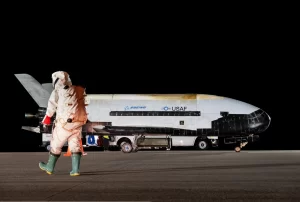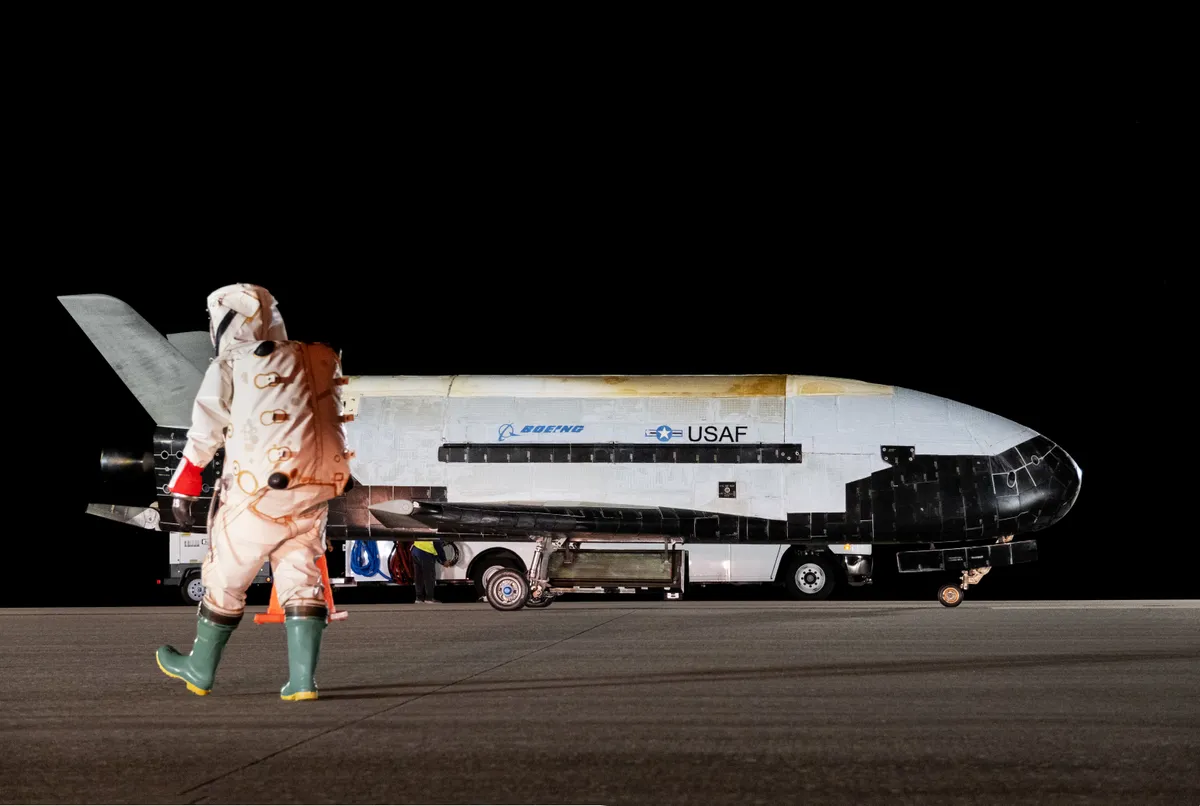
The mysterious reusable spaceplane, the X-37B Orbital Test Vehicle (OTV), has landed at NASA’s Kennedy Space Center after orbiting Earth for 908 days.
KENNEDY SPACE CENTER, Fla. — The X-37B Orbital Test Vehicle-6 (OTV-6), the U.S. Space Force’s unmanned, reusable spaceplane, successfully deorbited and landed at NASA’s Kennedy Space Center Shuttle Landing Facility on Nov. 12, 2022, at 05:22 a.m.
OTV -6 was the first mission to introduce a service module-a ring attached to the rear of the vehicle expanding the number of experiments that can be hosted during a mission. “This mission highlights the Space Force’s focus on collaboration in space exploration and expanding low-cost access to space for our partners, within and outside of the Department of the Air Force (DAF),” said Gen. Chance Saltzman, Chief of Space Operations.
The service module successfully separated from the OTV before landing, which is a necessary activity due to the aerodynamic forces experienced by the X-37B vehicle upon re-entry. In the coming weeks, the service module will be disposed of in accordance with best practices. Secretary of the Air Force Frank Kendall said, “The deliberate manner in which we conduct onorbit operations-to include the service module disposal-speaks to the United States’ commitment to safe and responsible space practices, particularly as the issue of growing orbital debris threatens to impact global space operations.”
The OTV-6 mission hosted the Naval Research Laboratory’s Photovoltaic Radiofrequency Antenna Module. This experiment successfully harnessed solar rays outside of Earth’s atmosphere and aimed to transmit power to the ground in the form of radio frequency microwave energy. Additionally, the U.S. Air Force Academy’s FalconSat-8, developed in partnership with Air Force Research Laboratory, was successfully deployed in October 2021. FalconSat-8 remains in orbit, providing Academy cadets unique hands-on experience as space operators prior to entering active duty.
Multiple NASA experiments were deployed on OTV-6. The Materials Exposure and Technology Innovation in Space (METIS-2) included thermal control coatings, printed electronic materials, and candidate radiation shielding materials. METIS-1-which flew on OTV-5-consisted of similar sample plates mounted on the flight vehicle. NASA scientists will leverage data collected after the materials have spent 900+ days in orbit and compare observed effects to ground simulations, validating and improving the precision of space environment models.
Another NASA experiment aims to investigate the effect of long-duration space exposure on seeds. Scientists are interested in the seeds’ resistance and susceptibility to space environment-unique stresses, notably radiation. The seeds experiment will inform space crop production for future interplanetary missions and the establishment of permanently inhabited bases in space.
“The X-37B continues to push the boundaries of experimentation, enabled by an elite government and industry team behind the scenes,” said Lt. Col. Joseph Fritschen, DAF Rapid Capabilities Office’s X-37B Program Director. “The ability to conduct on-orbit experiments and bring them home safely for in-depth analysis on the ground has proven valuable for the Department of the Air Force and scientific community. The addition of the service module on OTV-6 allowed us to host more experiments than ever before.”
The sixth mission conducted on-orbit experiments for 908 days.
Mission
The X-37B Orbital Test Vehicle, or OTV, is an experimental test program to demonstrate technologies for a reliable, reusable, unmanned space test platform for the U.S. Air Force. The primary objectives of the X-37B are twofold; reusable spacecraft technologies for America’s future in space and operating experiments which can be returned to, and examined, on Earth.
Features
The X-37B Orbital Test Vehicle is the newest and most advanced re-entry spacecraft. Based on NASA’s X-37 design, the unmanned OTV is designed for vertical launch to low Earth orbit altitudes where it can perform long duration space technology experimentation and testing. Upon command from the ground, the OTV autonomously re-enters the atmosphere, descends, and lands horizontally on a runway. The X-37B is the first vehicle since NASA’s Shuttle Orbiter with the ability to return experiments to Earth for further inspection and analysis, but with an on-orbit time of 270 days or greater, the X-37B can stay in space for much longer.
Technologies being tested in the program include advanced guidance, navigation and control, thermal protection systems, avionics, high temperature structures and seals, conformal reusable insulation, lightweight electromechanical flight systems, advanced propulsion systems, advanced materials and autonomous orbital flight, reentry and landing.
Background
The Department of the Air Force Rapid Capabilities Office is leading the Defense Department’s Orbital Test Vehicle initiative, by direction of the under secretary of defense for acquisition, technology and logistics and the secretary of the Air Force. The Air Force OTV effort uses extensive contractor and government investments in the X-37 program by the Air Force, NASA and the Defense Advanced Research Projects Agency to continue full-scale development and on-orbit testing of a long-duration, reusable space vehicle.
NASA’s original X-37 program began in 1999 and was transferred to DARPA in 2004. NASA envisioned building two vehicles, an Approach and Landing Test Vehicle, or ALTV, and an Orbital Vehicle. DARPA completed the ALTV portion of the X-37 program in 2006, executing a series of captive carry and free flight tests. DARPA successfully validated the flight dynamics and extended the flight envelope beyond the low speed/low altitude tests previously conducted by NASA on the X-40A, a sub-scale version of the X-37 developed by Air Force Research Labs. NASA’s X-37 Orbital Vehicle was never built, but it’s design was the starting point for the Air Force’s X-37B Orbital Test Vehicle program.

